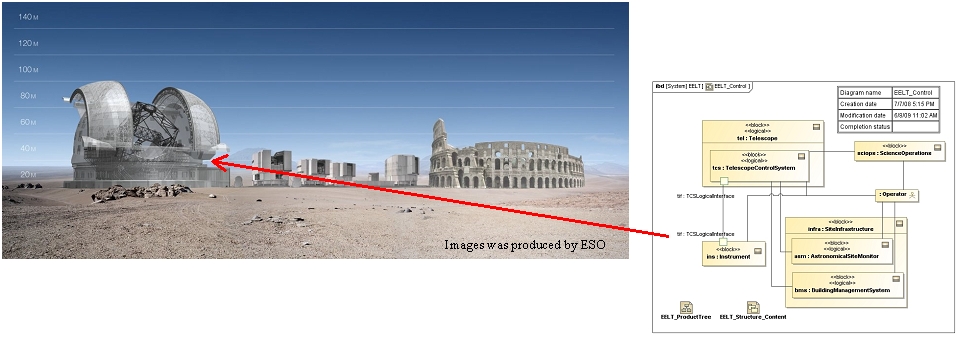mbse:e-eltelescope
This section contains information how the experiences of the Challenge team are applied to a new project, namely the telescope control system of the E-ELT.
Related Papers
TOWARDS A STATE BASED CONTROL ARCHITECTURE FOR LARGE TELESCOPES: LAYING A FOUNDATION AT THE VLT
- Abstract: Large telescopes are characterized by a high level of distribution of control-related tasks and will feature diverse data flow patterns and large ranges of sampling frequencies; there will often be no single, fixed server client relationship between the control tasks. The architecture is also challenged by the task of integrating heterogeneous subsystems which will be delivered by multiple different contractors. Due to the high number of distributed components, the control system needs to effectively detect errors and faults, impede their propagation, and accurately mitigate them in the shortest time possible, enabling the service to be restored. The presented Data-Driven Architecture is based on a decentralized approach with an end-to-end integration of disparate, independently-developed software components. These components employ a high-performance standards based communication middle-ware infrastructure, based on the Data Distribution Service. A set of rules and principles, based on JPL's State Analysis method and architecture, are use to constrain component to component interactions, where the Control System and System Under Control are clearly separated. State Analysis provides a model-based process for capturing system and software requirements and design, greatly reducing the gap between the requirements on software specified by systems engineers and the implementation by software engineers. The method and architecture has been field tested at the Very Large Telescope, where it has been integrated into an operational system.
Three years of MBSE for a large scientific programme: Report from the Trenches of Telescope Modeling
- Conference: 22nd INCOSE International Symposium 2012
- The most ambitious projects of the European Southern Observatory’s (ESO) is the construction of the European Extremely Large Telescope (E-ELT) which will be by far the world's largest optical and near-infrared telescope, and. will provide images 15 times sharper than those from the Hubble Space Telescope. Such a project poses continuous challenges to systems engineering due to its complexity in terms of requirements, operational modes, long operational lifetime, interfaces, and number of components. Since 2008 the Telescope Control System (TCS) team has adopted a number of Model Based Systems Engineering (MBSE) practices in order to cope with the various challenges ahead. This paper provides an overview of the different approaches we took during this time - which ones worked, and which did not.
- Paper will be added after the conference
mbse/e-eltelescope.txt · Last modified: 2016/07/09 06:55 by rkarban


